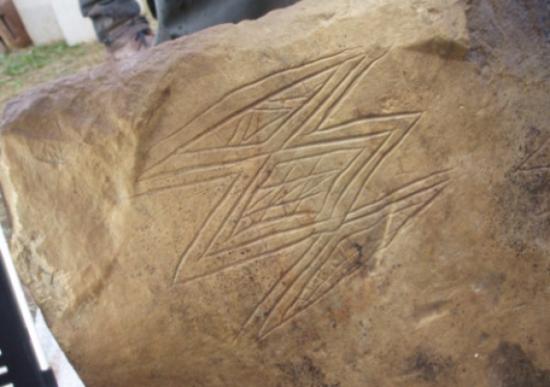Alistair Munro
Source - http://www.scotsman.com/news/scotland/top-stories/5-000-year-old-neolithic-art-found-in-orkney-dig-1-3026157

An image of the stone unearthed from the Ness of Brodgar site in Orkney. Picture: Nick Card
An archaeological dig on Orkney has unearthed some of the most important and finest Neolithic art ever found in the UK, dating back almost 5,000 years.
• Archaeologists in Orkney unearth 5,000-year-old Neolithic art
• Find is hailed as one of finest ever found at the Ness of Brodgar site
An intricately-inscribed stone was discovered by excited archaeologists at the Ness of Brodgar on Wednesday.
Nick Card, the excavation team director at the dig – which lies in the heart of Neolithic Orkney, between the Ring of Brodgar and the Stones of Strenness – said the latest find had created a “huge buzz” on the site.
The stone is unusual as it is artistically decorated on both sides and has impressive deep incisions.
Mr Card, of the Orkney Research Centre for Archaeology and based at the University of the Highlands and Islands in the islands, said: “It is perhaps the finest piece of art we have recovered from the site, and one of the finest from the UK ever – amazing and awe-inspiring.”
It was discovered by Mike Copper, a PhD student from Bradford University, in the buttress of a building believed to have been central to rituals and ceremonies at the time.
The team leader added: “The Ness of Brodgar has produced an amazing number of artefacts. This new stone is one of the best ever and created a huge buzz around the site.
“Mike and his team had taken a few days to excavate around the huge stone, as they knew it was of significance. Most stones of this type are given very close scrutiny.
“As we slowed to draw breath at the beauty of the revealed panel, a cry went up that an equally impressive design was apparent on one of the other sides of this large triangular block of stone.
“Although the basis of the designs of interconnecting triangles can be loosely paralleled on a slab discovered at Skara Brae in the 1970s, a lightly inscribed stone in Maeshowe discovered by Patrick Ashmore in the 1980s and some Irish art, this is a much finer and more complex piece of art.
“Many of the triangles are filled with cross-hatching and other designs.
“An initial wash has also revealed a finely incised chevron design and small cup marks.
“After careful recording in situ, plans were made to lift this large block and remove it to a location of ultimate security that is guarded by several burly archaeologists.
“The stone was protected with bubblewrap and then manoeuvred onto a large piece of very strong netting.
“Several pairs of hands at a given signal then lifted it onto the side of the trench and then into a well-padded wheelbarrow. There were cries of relief all round as it was made safe with no damage.”
Mr Card said Ness of Brodgar was most likely used for rituals and ceremonies during the Neolithic Age of almost 5,000 years ago, as it was surrounded by a large number of domestic settlements, including the famous Skara Brae.
He added: “The scale of stones used to quarry the Ness of Brodgar would have required a huge population to construct this.
“Up until now, Skara Brae had the most recorded Neolithic art in the UK, with about 70 panels. But we have already discovered 450 here. A new piece of decorative art comes up every day. We now have the largest collection in the UK.”
The remains of the massive Neolithic site which date back more than 5,000 years were discovered just over a decade ago.
Archaeologists said the discovery could be as significant as the prehistoric village at Skara Brae, which was unearthed in 1850.
Other finds have included a Neolithic mace head, pottery and decorated stones.
The archaeologists have been returning year on year to the site and resumed excavations last month for a six week dig.
Students from across the globe have gathered to carry out work.
Mr Card said: “This season, we’ll also have Dr Cathy Batt, from the University of Bradford, returning to take samples, for archaeomagnetic dating, from the various hearths across the site.
“The main objective this year is sampling and analysing the floor deposits, and carrying out more chemical analysis of the floor deposits on site to clarify how these buildings may have been used.”
The Ness of Brodgar is a thin strip of land, in the West Mainland of Orkney, separating the Harray and Stenness lochs.
Until recently, the Ness was best-known for being the site of the Ring of Brodgar. But in 2002 all that changed.
Archaeological excavations have subsequently revealed a large complex of ‘monumental’ Neolithic buildings, ‘artwork’, pottery, bones and stone tools.